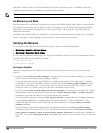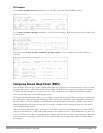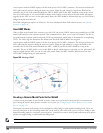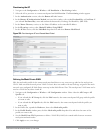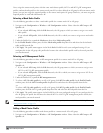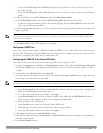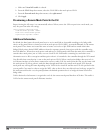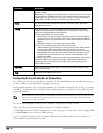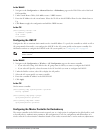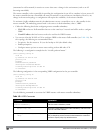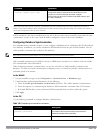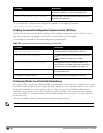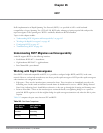
478 | VRRP DellPowerConnectW-SeriesArubaOS6.2 | User Guide
Parameter Description
emption is enabled.
When the timer is triggered, it forces VRRP to wait for a specified period of time, so that all
the applications are ready before coming up. This prevents the APs from connecting to the
controller before it can receive them. In the mean time, if there is an advertisement from
another VRRP, the VRRP stops the timer and does not transition to master.
Priority Priority level of the VRRP instance for the controller. This value is used in the election
mechanism for the
master.
Tracking Configures a tracking mechanism that modifies a specified
value
to the priority after a
controller has been the master for the VRRP instance. This mechanism is used to avoid
failing over to a backup Master for transient failures.
Tracking can be based on one of the following:
l Master Up Time: how long the controller has been the master. The value of
duration
is
the length of time that the administrator expects will be long enough that the database
gathered in the time is too important to be lost. This will obviously vary from instance to
instance.
l VRRP Master State Priority: the master state of another VRRP.
Tracking can also be based on the interface states of the controller:
l VLAN and Interface: prevents asymmetric routing by tracking multiple VRRP instances.
The priority of the VRRP interface determined by the
sub
value can increase or
decrease based on the operational and transitional states of the specified VLANor Fast
Ethernet/Gigabit Ethernet port. When the VLAN or interface comes up again, the value
is restored to the previous priority level. You can track a combined maximum of 16
interfaces and VLANs.
For example, you can track an interface that connects to a default gateway. In this situation,
configure the VRRP priority to decrease and trigger a VRRP master re-election if the
interface goes down. This not only prevents network traffic from being forwarded, but
reduces VRRP processing.
Admin State Administrative state of the VRRP instance. To start the VRRP instance, change the admin
state to UP in the WebUI.
VLAN VLAN on which the VRRP protocol will run.
Configuring the Local Controller for Redundancy
In a Dell network, the APs are controlled by a controller. The APs tunnel all data to the controller which processes
the data, including encryption/decryption, bridging/forwarding, etc.
Local controller redundancy refers to providing redundancy for a controller such that the APs
“
fail over
”
to a
backup
controller if a controller becomes unavailable. Local controller redundancy is provided by running VRRP between a
pair of Dell controllers.
NOTE: The two Dell controllers need to be connected on the same broadcast domain (or Layer-2 connected) for VRRP
operation. The two Dell controllers should be of the same class (for example, and both Dell controllers should be
running the same version of ArubaOS.
The APs are then configured to connect to the
“
virtual-IP
”
configured for the VRRP instance.
Collect the following information needed to configure local controller redundancy:
l VLAN ID on the two local Dell controllers that are on the same Layer-2 network and is used to configure VRRP.
l Virtual IP address to be used for the VRRP instance.
You can use either the WebUI or CLI to configure VRRP on the local Dell controllers. For this topology, it is
recommended to use the default priority value.



